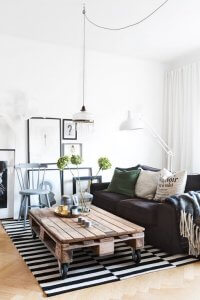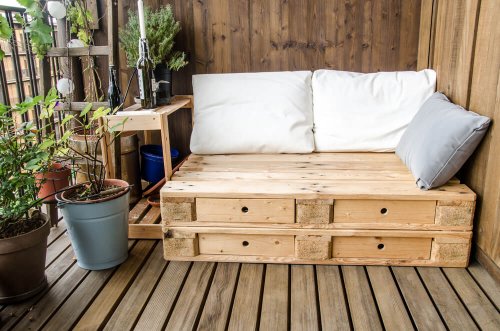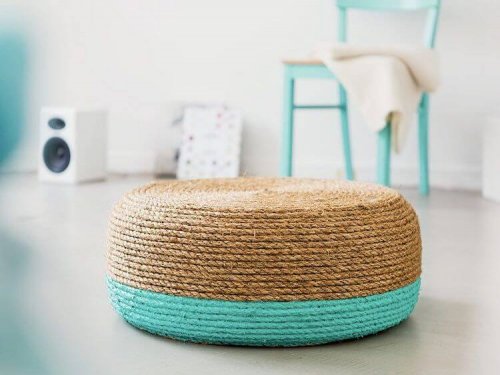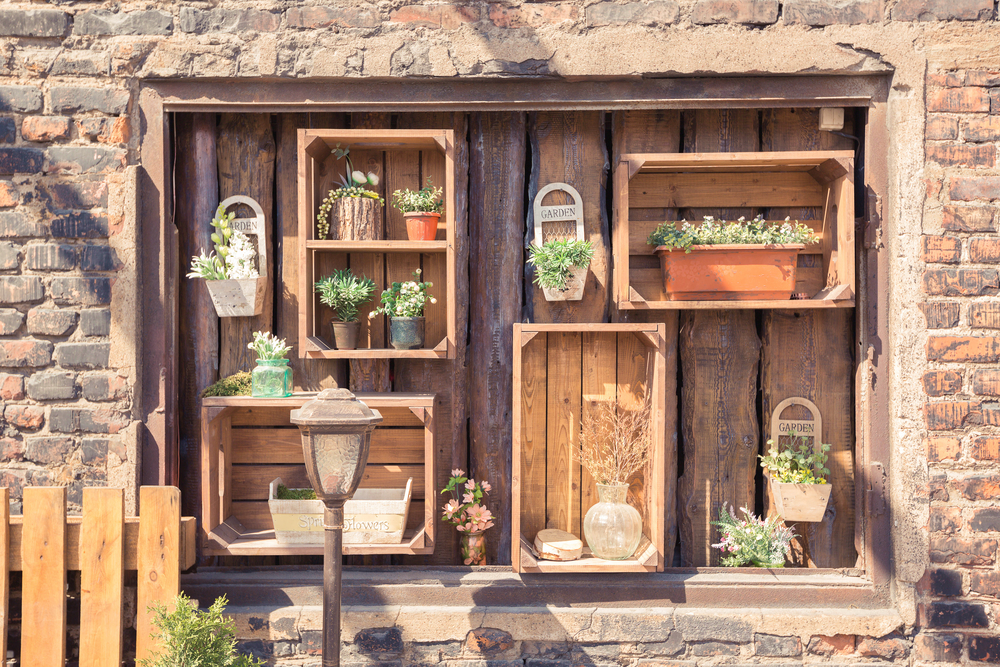5 Pieces of Advice on Making Your Own Furniture

These days, there are a lot of furniture options that are made to look artisan; some use a combination of materials like wood and iron.
Big companies are following the trend, using objects that you probably have laying around at home and want to throw out. You can make them into a table yourself, or a chair, coat-hangers, etc. In our post today, we’ll share 5 tips on making your own furniture just they way you like it.
Artisan pallet furniture
A pallet is normally used for cargo, aiding in the transportation of heavy objects. There are pallets of many sizes and kinds of wood. People normally throw them out.

- Sofas: You can use pallets as the main structure for a sofa. They work as a base, and you can add another to use as a back without having to attach them together. It’s a very simple structure that you can make more comfortable by adding the cushions of an old sofa.
You should clean the pallet thoroughly if you’ve picked it up in a wood pile, on the street, or if you had it sitting around at home. Even if the wood is in perfect condition, you should sand the surface and apply a couple layers of varnish or paint as a minimal treatment. With basic care, your pallets will be more visually appealing and last longer.
- Coffee table: Another simple, easy-to-make furniture is the famous coffee table, perfect for having guests over and sharing moments in your home. You can add four small wheels to the bottom of your pallet if you want to move it around your home. Or, you can simply leave it as it is, just giving it a protective finish.
Keep in mind that the space in between the boards of many pallets can be quite wide, possibly creating some inconveniences. Be careful because small items can slip through the spaces, or cups can spill over as well.
If you have a pallet that has very spaced out boards, you can solve this problem by placing a sheet of glass or a solid wood board on top of the pallet. That way, your coffee table will be much more practical and safely hold your items. On top of that, the design flows with the artisan style.
Artisan furniture with jute
Jute is a material that can add a lot of warmth to settings. Additionally, it’s relatively economical and quite easy to find.
Wooden furniture combined with jute is beautiful and economical; it’s great if you’re looking for a rustic, artisan look for your home.
- Hanging wood and jute shelves: We recommend using two or up to even four medium-sized wooden boards. First, make 4 small holes in corners of the wooden boards to later pass the jute through. After, you should sand the boards and apply a layer of varnish or paint.
Then, leave the wood to dry and pass the jute through the holes, connected all of the wooden boards that you’ve prepared.
If your jute is thinner than the diameter of the holes, try braiding three or more strands together for a thicker cord. It’ll also give your shelves a more artisan feel.
- Small poofs with tires and jute: Another simple furniture to make with jute is a poof, using a tire as its base structure. Take a tire that you don’t need and cover its entire surface with jute. You can apply it with superglue or any other strong adhesive.

Warning: never expose the poof to rain or direct UV rays because it could rot or dry out.
Artisan furniture with fruit crates
Similar to pallets, fruit crates are another common object all over the world. You can find them in homes, the local market or even by the dumpster. With fruit crates, you can create all kinds of artisan furniture pieces for your home.
- Coffee table: You should sand, clean and paint the crates before working with them. But beware: fruit crates are usually made with boards that aren’t very thick while being quite porous. So, choose your crates carefully, making sure that they’re in perfect condition. Apply some layers of paint because they’ll absorb them fast.

Wrapping up our tips, we encourage you to do a double take at that old, forgotten pallet or fruit crate in your garage, that rope that you bought a long time ago and don’t know what to do with, or those wooden boards that you have piled up in the corner.
Remember: recycling and restoring contributes to environmental efforts and even helps your wallet stay full. On top of that, what’s more satisfying than enjoying a coffee on a table that you crafted yourself?
These days, there are a lot of furniture options that are made to look artisan; some use a combination of materials like wood and iron.
Big companies are following the trend, using objects that you probably have laying around at home and want to throw out. You can make them into a table yourself, or a chair, coat-hangers, etc. In our post today, we’ll share 5 tips on making your own furniture just they way you like it.
Artisan pallet furniture
A pallet is normally used for cargo, aiding in the transportation of heavy objects. There are pallets of many sizes and kinds of wood. People normally throw them out.

- Sofas: You can use pallets as the main structure for a sofa. They work as a base, and you can add another to use as a back without having to attach them together. It’s a very simple structure that you can make more comfortable by adding the cushions of an old sofa.
You should clean the pallet thoroughly if you’ve picked it up in a wood pile, on the street, or if you had it sitting around at home. Even if the wood is in perfect condition, you should sand the surface and apply a couple layers of varnish or paint as a minimal treatment. With basic care, your pallets will be more visually appealing and last longer.
- Coffee table: Another simple, easy-to-make furniture is the famous coffee table, perfect for having guests over and sharing moments in your home. You can add four small wheels to the bottom of your pallet if you want to move it around your home. Or, you can simply leave it as it is, just giving it a protective finish.
Keep in mind that the space in between the boards of many pallets can be quite wide, possibly creating some inconveniences. Be careful because small items can slip through the spaces, or cups can spill over as well.
If you have a pallet that has very spaced out boards, you can solve this problem by placing a sheet of glass or a solid wood board on top of the pallet. That way, your coffee table will be much more practical and safely hold your items. On top of that, the design flows with the artisan style.
Artisan furniture with jute
Jute is a material that can add a lot of warmth to settings. Additionally, it’s relatively economical and quite easy to find.
Wooden furniture combined with jute is beautiful and economical; it’s great if you’re looking for a rustic, artisan look for your home.
- Hanging wood and jute shelves: We recommend using two or up to even four medium-sized wooden boards. First, make 4 small holes in corners of the wooden boards to later pass the jute through. After, you should sand the boards and apply a layer of varnish or paint.
Then, leave the wood to dry and pass the jute through the holes, connected all of the wooden boards that you’ve prepared.
If your jute is thinner than the diameter of the holes, try braiding three or more strands together for a thicker cord. It’ll also give your shelves a more artisan feel.
- Small poofs with tires and jute: Another simple furniture to make with jute is a poof, using a tire as its base structure. Take a tire that you don’t need and cover its entire surface with jute. You can apply it with superglue or any other strong adhesive.

Warning: never expose the poof to rain or direct UV rays because it could rot or dry out.
Artisan furniture with fruit crates
Similar to pallets, fruit crates are another common object all over the world. You can find them in homes, the local market or even by the dumpster. With fruit crates, you can create all kinds of artisan furniture pieces for your home.
- Coffee table: You should sand, clean and paint the crates before working with them. But beware: fruit crates are usually made with boards that aren’t very thick while being quite porous. So, choose your crates carefully, making sure that they’re in perfect condition. Apply some layers of paint because they’ll absorb them fast.

Wrapping up our tips, we encourage you to do a double take at that old, forgotten pallet or fruit crate in your garage, that rope that you bought a long time ago and don’t know what to do with, or those wooden boards that you have piled up in the corner.
Remember: recycling and restoring contributes to environmental efforts and even helps your wallet stay full. On top of that, what’s more satisfying than enjoying a coffee on a table that you crafted yourself?







